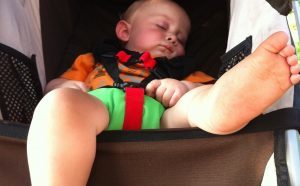
If your infant’s stroller is recalled because of a safety issue, will the manufacturer be able to contact you?
 1. Strollers help keep infants and toddlers safe but only if (1) the stroller is structurally sound and (2) you use it correctly. Recalls of basic child-related items occur frequently, says the US Consumer Product Safety Commission (USCPSC). See Recalls here: CPSC Recall list Such items also include carrying slings, carriages, cribs, highchairs and changing tables. Among these products, strollers are the leading cause of injuries, accounting for about 14,000 US emergency rooms visits each year. This year, 800 strollers were recalled. In 2013, 200,000 were recalled due to a potential strangling hazard.
1. Strollers help keep infants and toddlers safe but only if (1) the stroller is structurally sound and (2) you use it correctly. Recalls of basic child-related items occur frequently, says the US Consumer Product Safety Commission (USCPSC). See Recalls here: CPSC Recall list Such items also include carrying slings, carriages, cribs, highchairs and changing tables. Among these products, strollers are the leading cause of injuries, accounting for about 14,000 US emergency rooms visits each year. This year, 800 strollers were recalled. In 2013, 200,000 were recalled due to a potential strangling hazard.
2. Staying in contact with the manufacturer is your responsibility. You must register your stroller (or other items) with the manufacturer at the time of purchase, notify them each time you change your contact information, and respond to messages they send you – which many people fail to do. You can also check for recalls. USCPSC maintains a registry of recalls involving children-related items. See Saferproducts.gov or call UPCPSC at 1-800-638-2772. The name of the manufacturer model and serial numbers of the item you are checking are provided somewhere on the product.

3. Seventy-five percent of stroller-related injuries result from children falling out of them. Usually, infants are improperly strapped in. “I just turned my back to turn off the water” is typical. Infants slide down between the hand tray and the bottom of the seat. While the body fits through this space, the head becomes entrapped, compromising the infant’s ability to breathe. Other recent recalls involved children seriously injuring fingers in the mechanisms of fold-up strollers and falling out when handlebars became disengaged. Other mishaps include “tip-overs,” “collapses,” and “runaways”.
4. Umbrella strollers cause the majority of stroller-related injuries. They are lightweight, simple to set up and maneuverable. However, these features make them prone to tipping over, often due to heavy objects hanging on the handlebars or overloading storage areas. Strollers with wide bases are less likely to tip over. Keep infants away from the stroller as you open and fold it; their fingers can get caught in the hinges. Make sure that umbrella strollers are “clicked in” when opened. If not, the stroller may collapse while you push it. Engage the brakes whenever you take your hands off the handlebar. Umbrella strollers’ lightness enables them to roll down slopes so slight that you may be unaware that a slope exists.


5. Most umbrella strollers are not designed for young infants. Younger infants must lie flat on their backs; popular models of umbrella strollers do not provide the head support that infants require. Umbrella strollers are safe to use once infants can hold their heads up while sitting with support (usually by five to six months).
6. Other safety recommendations. Read the product manual. Check that infants’ fingers cannot reach the wheels. Strollers left in the sun in hot weather can cause plastic and metal pieces to become hot and cause burns. A shade for the stroller is a helpful accessory. In strollers that allow an older child to sit or stand in the rear, keep in mind weight guidelines and keep children from moving around so they don’t tip the stroller.
7. Hand-me-down strollers are rarely bargains. Injuries have occurred because fabric covering hardware is torn, exposing bolts and screws, for example. In most cases, the newer the model, the safer it is. Newer models benefit from improved technology, more stringent government regulations, feedback from users, and no wear and tear from usage.


8. How long is too long to allow infants to sleep in car seats/strollers? “Travel systems” allow parents to transfer sleeping infants from car seats to stroller bases without waking, an appealing feature for parents. Ideally, young infants should sleep flat on the backs. Sitting semi-upright for lengthy periods can contribute to developing flat spots on the back of infants’ heads, worsen reflux, if present, and affect breathing. Generally, infants should sleep in strollers/car seats no longer than two hours, with regular monitoring.
9. Infants in strollers do not belong on stairs/escalators! Use elevators when available, have someone carry the stroller or infant while you carry the other, or if you are by yourself, carry the infant and stroller separately (not an easy task). Stroller/escalator accidents are especially common at airports. You may be rammed by people pushing luggage or your stroller may not be positioned correctly for escalator stairs to rise or fall. At airports, elevators are available where there are escalators or stairs, but they are frequently out of sight. Ask.
10. Size tips. When purchasing a safe stroller, check that the handlebars are at waist level or slightly lower and that you can steer it in a straight line when pushing with one hand. It is unsafe for young children to push a stroller while an infant is seated in it. Infants gain weight and grow rapidly; check your manual from time to time to see if your infant has outgrown your stroller. In parking lots, drivers can have difficulty seeing strollers. Keep the stroller close to your car and stand next to it. Always think about stroller safety!

